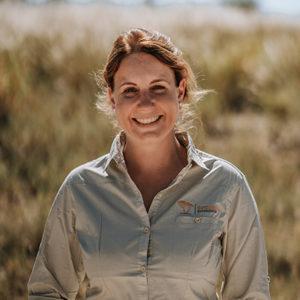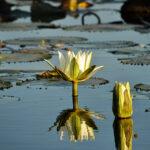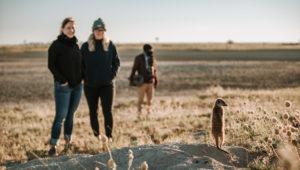Makgadikgadi & Nxai Pans National Parks
16,000 sq. km
1970 (Game Reserve) | 1992 (National Park)
All year
The largest complex of salt pans in the world
The Makgadikgadi Pans combined with the smaller pans of Sua, Nwetwe and Nxai cover over 16,000 km2 (6,200 sq. mi), thereby forming the largest salt complex in the world. It is a place of stark contrasts: during the wet season, the vast and dry salt pans turn into a habitat for large herds of zebras and antelopes.

A place of mystery and natural beauty
What would happen if a gigantic super lake were to drain and eventually, dry out? When you visit the Makgadikgadi, you might find it hard to believe that the area around you was once covered by a massive lake. It is the vast salt flats which you see all the way onto the horizon that can show you what happens. It creates a unique landscape, beautiful in its bareness and marvellous in its ability to transform from a dry salt pan to a place where wildlife flourishes after the rains.
The Makgadikgadi Pan is the largest in a complex of salt pans which also includes the Nxai, Nwetwe and the Sua Pans. Together they form the largest salt pan complex in the world. The almost endless wide expanses of the salt pans stretching out onto the horizon can provide you with an exhilarating sense of isolation. You are surrounded by deafening silence, and it is in this silence that you can admire the most spectacular sunrises and sunsets.
The Nxai Pan is older than the Makgadikgadi Pan and is grass covered with clusters of acacias and gigantic baobabs dotted across the landscape. None of these baobabs are more famous than Baines’ Baobabs. Named after the explorer Thomas Baines, these seven impressive baobabs still stand as proud as they did one hundred years ago when Baines first painted them.
Explore Kubu Island, a place shrouded in mystery. Located on the Sua Pan, this outcrop of igneous rock is an “island” in a vast sea of salt flats. The island was once exactly that, an island in the massive Lake Makgadikgadi. Rounded pebbles still point to a time when the waves of the lake would crash against its rocks. The entire island is a national monument and is considered sacred to the local San (or sometimes known as Basarwa in Botswana). It contains prehistoric artifacts and a stone wall, shaped in a semi-circle. The origins of the stone wall we can only speculate on. What we can definitely say however, is that a sunset seen from Kubu Island is one not easily forgotten.
It is always the best season to visit the Makgadikgadi as the dry season and the wet season offer you two completely different perspectives and different activities. During the dry season (April to October), conditions are harsh, and the landscapes can best be admired for their haunting beauty. It is during this season when one can drive over the pans, have a sleep-out on the pans themselves and revel in the most stunning starlit sky. During the wet season on the other hand (November to March), the region comes alive with massive herds of migrating zebra and wildebeest in search of the fresh grasses which the rains bring. Other animals which can be seen include impala, springbok, eland, oryx, lion, leopard, cheetah, hyena and sometimes even elephant.
Should you be interested in bird watching, then the wet season is the one for you. During this time, hundreds of thousands of flamingos along with flocks of pelicans, ducks and geese come to the waterfilled pans and transform them into a bird lover’s paradise.
The Makgadikgadi offers something uniquely beautiful to everyone, no matter when you plan to travel. As you stare out over the distant horizon, with the sunset illuminating the sky around you, you can feel the mystique surrounding the Makgadikgadi and know that this is a feeling you will carry with you for a long time.
Contrasting & Unique Experiences
You can have two completely unique experiences at the Makgadikgadi. The dry season reveals immense salt flats of desolate beauty, and the wet season brings large numbers of migratory birds and wildlife.
Visit Kubu Island
You can step onto Kubu Island, a place shrouded in mystery and sacred to the San. The island’s giant baobabs create the backdrop for one of the most stunning sunsets you will ever see.
Migration of the South
You can witness the longest animal migration in the world. During the rainy season, tens of thousands of Burchell’s zebras and blue wildebeest arrive at the Makgadikgadi Pans.
WHEN TO GO
Best time to go to the Makgadikgadi Salt Pans
You should ideally visit the Makgadikgadi at least twice in your life. Once during the dry season when you will be awed by the all-embracing expansive salt pans which stretch so far onto the horizon that you can see the curvature of the earth. And once during the wet season when the pans fill with water and fresh grass grows, attracting predators and prey alike.
Dry Season
April to OctoberBest for a sleep-outs on the salt pans
Green Season
November to MarchBest for wildlife sightings and zebra migration
Why to go
A sunset and night sky like no other
The Makgadikgadi provides you with a beauty unlike anywhere else. Wide, flat salt pans, covering vast open spaces, accompanied by deafening silence and one of the most beautiful sunsets followed by night skies you are likely to ever see. Mystic baobabs and a stark contrast between the seasons make this a place like no other.


The Makgadikgadi Salt Pans are incredibly impressive. Being in the bush in Africa is great, but I have always been fascinated by the sheer nothingness in the pans. The sunrise with its spectacular cloud formations and the void of the pan is simply incredible. The night sky here is like nothing I have ever seen. You are so far away from any other civilization that it is just you, the darkness, and the stars.Marlene | Botswana Travel Expert
Where to stay in the Makgadikgadi
Location
The collection of salt pans that make up the Makgadikgadi Pans National Park are located in the North-East of Botswana, South of Chobe, and South-East of the Moremi Game Reserve. You can reach it by 4×4 vehicle from Maun on a self-drive or guided tour or charter a private plane.



Experience Botswana with us
Speak to one of our local advisors
Let's start planning your trip!
We will get back to you within 2 working days.



















